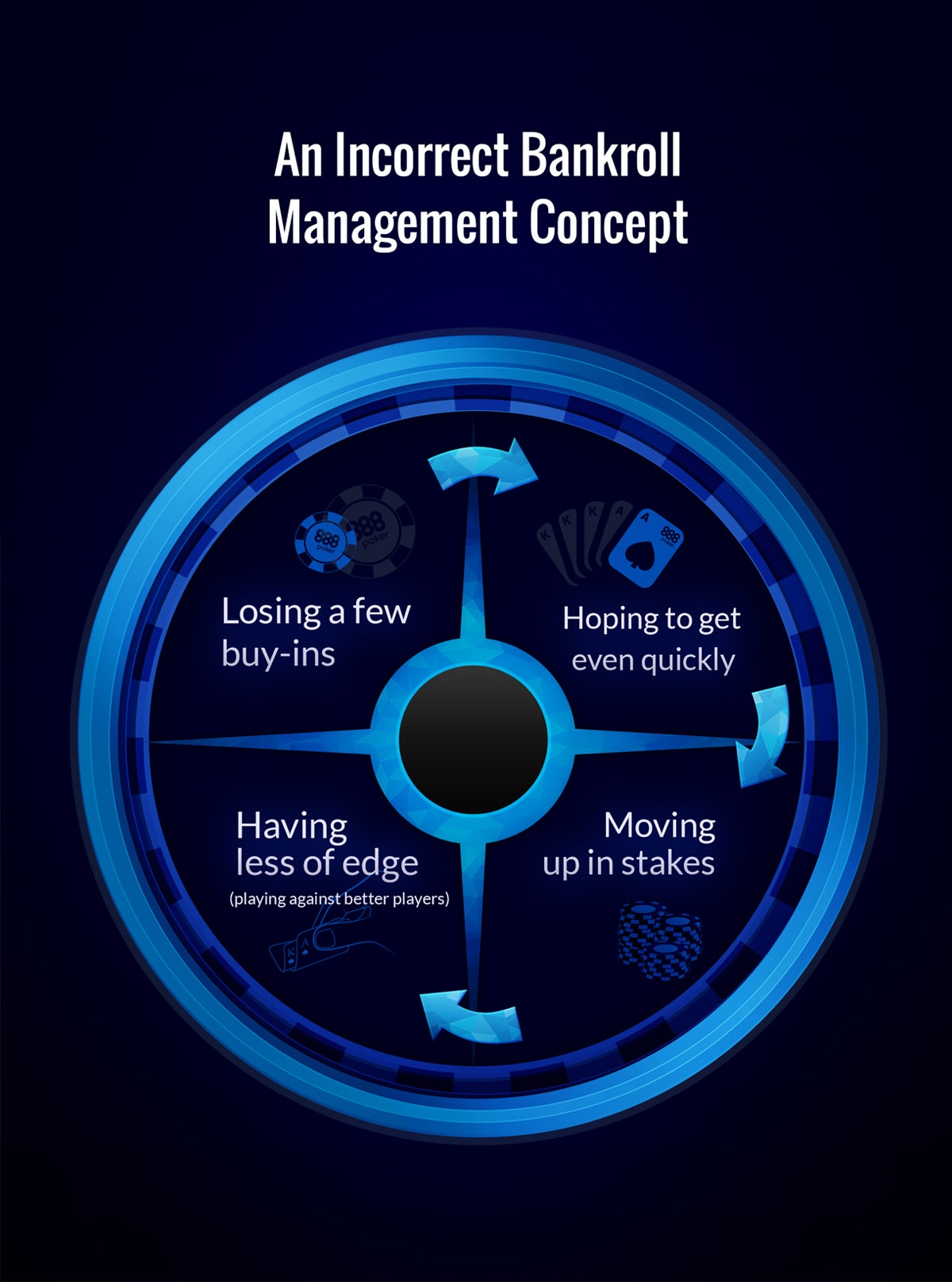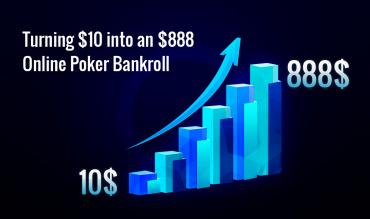Your technical skills at the poker table are the main determining factor as to whether you are a profitable player. However, most professionals agree that poker bankroll management is another skill that must be mastered if you want to succeed in the long run.
While it is true that no amount of “poker bankroll management” will turn a losing player into a winning player, it can help to ensure winning players stay in action, allowing them to continue grinding out their edge indefinitely.
It doesn’t matter how good you are if you are constantly unable to play due to the normal fluctuations of the game.
A few online poker sites offer sweet deposit bonuses where if you deposit $10, they will give you another $10 for free, meaning you double your money on the spot.
Completely free money is a great way to get an initial boost to your poker bankroll!
Table of Contents
An Incorrect Poker Bankroll Management Concept
Before getting started, I want to reiterate that no amount of poker bankroll management will save a losing player (See my other articles for advice on improving your technical skills). Many players mistakenly believe they can implement a system of moving up and down that will ensure they eventually win.
A classic example of this is the inept Martingale system for casino games like Roulette, Blackjack, and Baccarat, where you place a bet and if you win, you place the same bet. But if you lose, you double your bet. The logic is that you have to win a bet eventually.
However, if you start by only betting $1 and you lose eight bets in a row, your next bet will be $256, which is significantly more than most $1 bettors are willing to risk. Believe it or not, if you place enough bets, you will eventually lose eight in a row. If you lose that $256 bet, you then have to slide out a $512 bet, and then a $1024 bet, all in the hopes of recouping your initial $1 loss. To further thwart this system, casinos have table maximums, so you may not even be allowed to make a bet over perhaps $500, which throws additional kinks into this losing system.
Whenever you place a bet, you either win or lose some amount of equity. With the $1 Roulette bet, the casino will win 5.26% on average every time you spin (on tables with two green slots). This means that for every dollar you bet, you lose 5.26 cents. It is as simple as that. No matter what system you devise, if you make losing bets, you will lose in the long run.
So, if you bet $1 each spin over the course of 100 spins, you should expect to lose $5.26 on average. Sometimes you will win a lot and other times you will lose a lot, but if you repeat the process over and over, you will see that you are a consistent loser. If you decide to make gigantic bets in the hope of “getting even”, you will lose even more, due to your drastically increased bet size, although still at the rate of 5.26%.
You may be wondering how even-money casino games relate to poker. Well, many players use a similar system by playing $10 NL (with $.05/$.10 blinds), and if they lose a few buy-ins, they move up to $25 NL where they have less of an edge (because the players are better as you vie for more money). If they lose a few buy-ins at $25 NL, they move higher and higher until they lose their entire poker bankroll.

Protecting Your Poker Bankroll
This strategy of moving up incredibly aggressively (whether you are a winning or losing player) is not recommended because it only takes a few losses to put you out of action. If you are a winning player, the goal is to stay in action so you can play indefinitely, allowing you to consistently make money whenever you take a seat at the poker table. Also, if you bust your initial $10 deposit (now $20, thanks to the deposit bonus), you essentially fail the challenge, which is not the desired result.
It is important to understand that you will always have some chance of losing your poker bankroll, even if you keep a large one. You must decide how comfortable you are with losing the money in your account and having to reload. If you have a full-time job and $10 is essentially meaningless to you, feel free to move up and down aggressively. If $10 is all your money in the world, you should protect it vigilantly, only risking a tiny chunk of your bankroll at any given time.
To be perfectly clear, your “bankroll” is the money you have set aside purely for playing poker. It should not be used for anything else. Fortunately, when you deposit in an online poker site, that money is clearly separated from your other money and is easily designated as only for poker.
Professional Poker Bankroll Strategy
Once they reach the highest levels, most professionals implement incredibly protective poker bankroll management because if they go broke, it is detrimental to their careers. Even if you have a sizable edge, it is not worth it to risk a large chunk of your poker bankroll if it opens you up to going broke.
For example, if I was proposed a bet for my entire net worth on a coin flip where if I win, I get three times my bet and if I lose, I lose my bet, I would decline it - even though the bet is clearly incredibly profitable for me in the long run.
If I lost everything I worked so hard for over the last 14 years as a professional poker player, it would be a disaster, whereas if I tripled my poker bankroll, it would be nice, but not life-changing.
Remaining in action is vitally important.
Give This Strategy a Try
While I could bore you with somewhat complicated math equations pertaining to poker bankroll management, I want to keep this article simple and actionable. Simply put, your poker bankroll depends on your win rate, the variance in your game (based on the game type and your strategy), and your tolerance for risk of going broke.
When you deposit $10 into your account and have a total of $20 (thanks to the online site giving you $10 for free), I suggest you hop into $2 NL ($.01/$.02, where you buy in for $2). Play for a while until it is clear you are a winning poker player. With 10 buy-ins ($2 X 10 = $20), you will be somewhat likely to go broke, but that is a risk you must take when you start with such a small deposit.
If you win at about 10 big blinds per 100 hands (which is certainly doable in the smallest stakes games), you need about 4,000 big blinds to comfortably play with a relatively low risk of ruin. I do not think that minimising the likelihood of going broke is of the utmost importance to most of you reading this article. So, I will assume you want to keep about 20 buy-ins in your poker bankroll while looking to aggressively move up, especially if can find a juicy game.
I suggest you use the following plan when attempting to run your $10
- Play $2 NL until you have $60, and then move to $4 NL.
- Play $4 NL until you have $90, and then move to $6 NL. If your poker bankroll gets down to $40 at any point, move back to $2 NL.
- Play $6 NL until you have $150 and then move to $10 NL. If your poker bankroll gets down to $120 at any point, move back to $6 NL.
- Play $10 NL until you have $375 and then move to $25 NL. If your poker bankroll gets down to $200 at any point, move back to $6 NL.
There you have it! You will certainly encounter some significant swings to your poker bankroll using this aggressive approach, but if you have a substantial edge, you will have a relatively minimal risk of going broke.
Just be sure to remain disciplined and move down as outlined if things go poorly.
Be Disciplined Enough to Move Back Down
Many players fall into the trap of thinking they are $10 NL players once they get to $10 NL. They refuse to move down, thinking those games are “below them”, and eventually go broke due to the natural swings of the game. The approach outlined is quite robust because you essentially double your poker bankroll every time you move down, keeping you in action.
If you find the swings are a bit too wild for you, feel free to raise the amounts you need in all situations. By keeping a larger poker bankroll, you will encounter smaller swings in terms of percentage of your poker bankroll, which you may find allows you to play your best more often.
Many players get anxious and make significant blunders when they are playing for 5% (or more) of their poker bankroll. If the money matters a lot to you, you are probably playing too big. Ideally, you want to play your best regardless of how much money you are risking, whether it is a little or a lot.
As you move up, you should keep more buy-ins in your poker bankroll. This is because you will have a smaller edge due to playing against better opponents. You will inevitably reach a level where you are no longer a winner. I will present a proven strategy for moving up in stakes and staying there in the next article of this five-part series.
Don’t Cash Out (Yet!)
You may notice that I did not mention cashing out any of your profits. Just like a startup company, when you are in the “poker bankroll building” phase, your goal is solely to build the poker bankroll, not to take out profits. There will be plenty of time for that once you learn to win at a significant hourly rate. For now, resolve to put in lots of hours at the table and tackle poker in a disciplined manner.
If you have any questions at all, feel free to ask me on twitter @JonathanLittle. Good luck!


